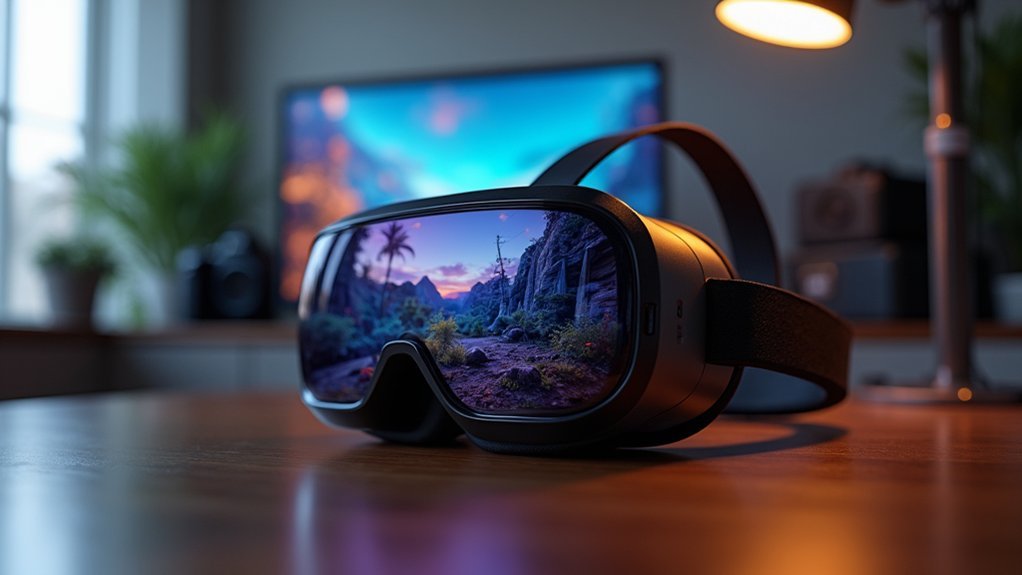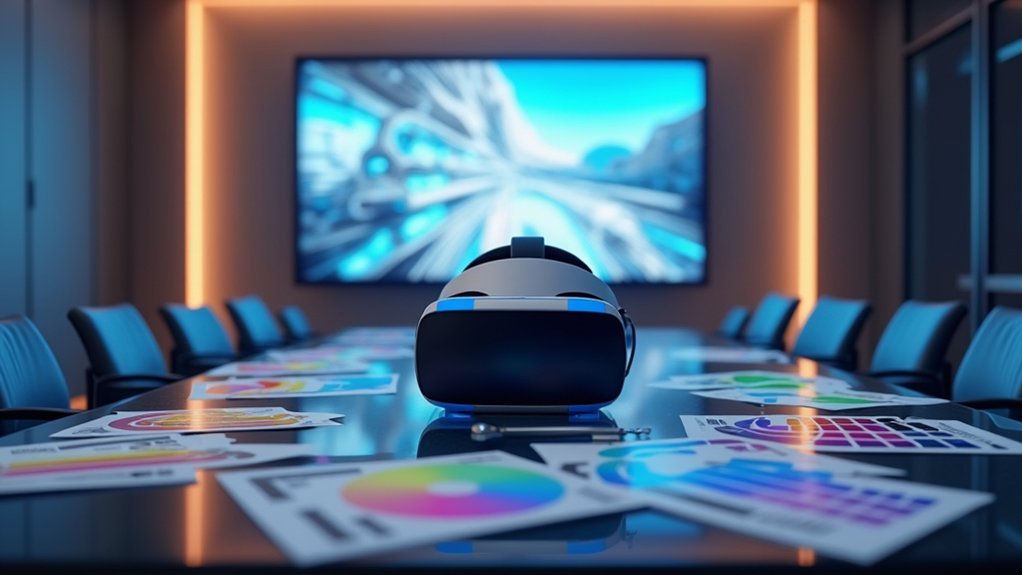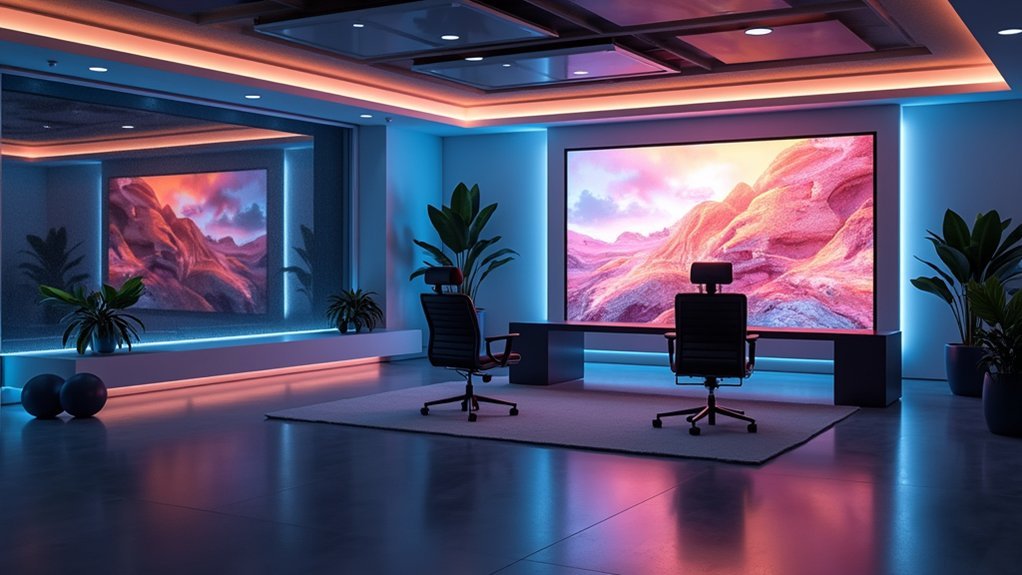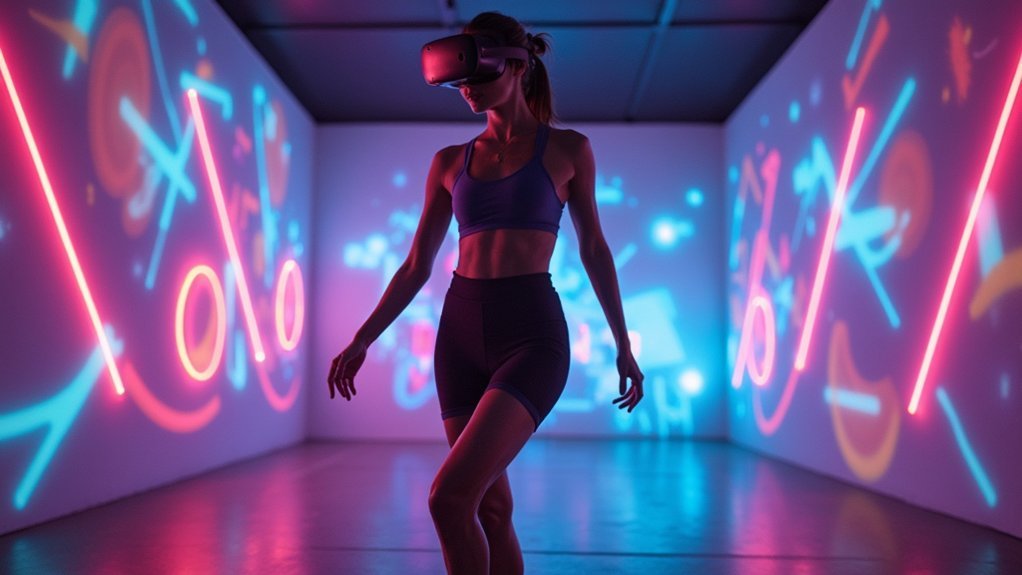You’ll need to achieve a minimum of 1080p resolution per eye, maintain 90+ FPS frame rates, and guarantee sub-20ms latency to meet professional VR visual standards. Your hardware should include at least an Intel i5 processor, 8GB RAM, and NVIDIA GTX 1060 graphics card. Implement proper anti-aliasing techniques like MSAA or TAA to eliminate jagged edges, and calibrate displays for consistent color reproduction. These benchmarks prevent motion sickness and deliver the crisp, responsive experience business users expect from virtual meetings—and there’s much more to optimizing your setup.
Essential Display Resolution Requirements for Professional VR Applications

When developing professional VR applications, you’ll need to meet specific display resolution standards that directly impact user experience and content effectiveness. You should target a minimum of 1080p per eye, though higher resolutions greatly improve visual quality.
Higher-end headsets like the Oculus Rift deliver 2160×1200, while the HTC Vive reaches 2880×1600, considerably reducing the screen-door effect that can distract users.
You’ll want to prioritize pixel density above 600 PPI for sharper images that allow users to focus on detailed content without strain.
Professional VR applications benefit from advanced rendering techniques like foveated rendering, which optimizes performance by reducing workload in peripheral areas while maintaining high visual fidelity where users focus most.
Frame Rate Standards and Motion Smoothness in Business Virtual Reality
While resolution determines visual clarity, frame rate drives the smoothness that makes or breaks your professional VR experience.
Meeting proper frame rate standards guarantees your business VR applications deliver the motion smoothness necessary for productive meetings and presentations.
You’ll need to target these critical benchmarks for peak performance:
- 60-90 FPS minimum: Prevents motion sickness and maintains comfortable viewing during extended sessions
- 90+ FPS preferred: Delivers the visual stability required for professional interactions and complex demonstrations
- Sub-20ms motion tracking latency: Eliminates delays between your movements and virtual representation
- Consistent refresh rates: Matches frame rates to prevent visual artifacts during rapid movements
Lower frame rates cause juddering and lag that’ll compromise your immersive experience.
Poor frame rates destroy immersion through jarring visual stutters that sabotage professional VR productivity and user comfort.
When users feel disoriented or uncomfortable, productivity plummets and your investment in VR technology becomes counterproductive.
Color Accuracy and Calibration Protocols for VR Meeting Environments

Beyond achieving smooth motion, your VR meeting environment’s color accuracy directly impacts how participants perceive shared content and collaborate effectively.
You’ll need established calibration protocols to maintain visual fidelity across different headsets and hardware configurations. Start by adjusting brightness, contrast, and color settings on each device to create consistent representation.
Implement standardized calibration tools or software that guarantee uniform visual experiences, eliminating discrepancies between participants’ displays. You can’t rely on factory settings alone—hardware drift occurs over time, requiring regular recalibration sessions.
Test your setup using color charts or reference images during initial configuration. This verification process helps you align with professional visual standards and identify adjustment needs.
Regular calibration maintenance guarantees colors remain accurate throughout multiple meetings, preserving the integrity of shared presentations and visual materials.
Anti-Aliasing and Edge Smoothing Techniques for Sharp Visual Presentation
You’ll need to implement robust anti-aliasing methods to eliminate the jagged edges that can undermine your VR meeting’s professional appearance.
Modern edge smoothing algorithms like MSAA and TAA offer different performance-quality trade-offs that you must evaluate based on your hardware constraints and visual requirements.
Your choice between techniques such as FXAA for speed or higher-quality solutions will directly impact both user comfort and the credibility of your virtual workspace.
Anti-Aliasing Implementation Methods
When you develop VR applications, anti-aliasing becomes essential for eliminating the jagged edges that can break immersion and create a pixelated appearance.
Choosing the right implementation method directly impacts both visual quality and performance in your immersive experience.
You’ll encounter several effective anti-aliasing techniques:
- Multisample Anti-Aliasing (MSAA) – Samples multiple points within each pixel and averages them for smoother boundaries.
- Fast Approximate Anti-Aliasing (FXAA) – Applies post-processing filters across the entire rendered image for quick results.
- Super Sampling Anti-Aliasing (SSAA) – Renders scenes at higher resolutions before downscaling for maximum sharpness.
- Temporal Anti-Aliasing (TAA) – Uses information from previous frames to reduce flickering and improve edge quality.
Consider your hardware limitations when selecting methods, as SSAA delivers superior results but demands considerably more processing power than FXAA’s efficient approach.
Edge Smoothing Algorithms
Since edge smoothing algorithms form the technical foundation of anti-aliasing, understanding their underlying mechanisms helps you improve visual quality while maintaining frame rates in VR environments.
You’ll find that Multisample Anti-Aliasing (MSAA) samples multiple points per pixel to eliminate jagged edges on curved and diagonal lines. Temporal Anti-Aliasing (TAA) leverages previous frame data to smooth edges while preserving performance efficiency.
These anti-aliasing techniques directly impact your immersive virtual experience by reducing distracting artifacts that can break presence.
When you implement proper edge smoothing, you’ll achieve superior visual clarity that meets professional standards. The result is sharper, more lifelike objects that reduce visual fatigue during extended sessions.
Strategic algorithm selection guarantees you maintain peak frame rates while delivering the polished visuals essential for professional VR applications.
Lighting Design Principles for Professional Virtual Workspaces

Although you might naturally focus on visual elements when designing virtual workspaces, lighting design serves as the foundation that makes everything else possible. Proper illumination levels between 300-500 lux guarantee ideal visibility while reducing eye strain during extended VR meetings.
You’ll achieve professional standards by implementing these four key elements:
- Balanced lighting combination – Blend ambient, task, and accent lighting for immersive experiences.
- Natural color temperature – Use 4000K-5000K range to simulate daylight and promote alertness.
- Strategic light positioning – Minimize shadows and glare that distract participants.
- Adjustable lighting systems – Enable customization based on meeting requirements and participant preferences.
This thorough approach transforms virtual workspaces into professional environments where participants can engage effectively without visual distractions or discomfort.
Hardware Performance Benchmarks for Consistent Visual Quality Delivery
You’ll need specific hardware performance benchmarks to maintain professional visual standards across all VR meeting scenarios.
Your system must meet minimum requirements like a GTX 970 GPU, 16GB RAM, and Intel i5-4590 processor to deliver consistent 90Hz refresh rates that prevent motion sickness during presentations.
Testing these performance metrics against quality assurance standards guarantees your virtual workspace maintains the visual fidelity that clients and colleagues expect from professional interactions.
Minimum Hardware Requirements
While establishing professional visual standards in virtual reality demands careful attention to technical specifications, your hardware foundation determines whether you’ll achieve consistent, high-quality results.
Meeting minimum hardware requirements guarantees your VR headsets deliver the performance professionals expect.
Your high-end PC must include these essential components:
- Processor Power: Intel i5 or AMD Ryzen 5 minimum for smooth processing
- Memory Capacity: 8GB RAM to handle complex VR applications efficiently
- Graphics Performance: NVIDIA GTX 1060 or AMD Radeon RX 480 for crisp visuals
- Display Standards: 1080×1200 pixels per eye minimum resolution
You’ll need consistent 90 FPS performance to prevent motion sickness and maintain immersion.
USB 3.0 connectivity guarantees reliable data transfer, while 25 Mbps internet bandwidth supports seamless multiplayer experiences.
Performance Testing Metrics
Since your VR hardware foundation is established, measuring specific performance benchmarks guarantees you’ll deliver consistent visual quality that meets professional standards.
Performance testing metrics focus on four critical areas that directly impact user experience.
You’ll need to maintain frame rates at 90 FPS or higher to prevent motion sickness and guarantee smooth interactions. Latency must stay below 20 milliseconds for real-time responsiveness during virtual meetings.
Resolution benchmarks require minimum 1080×1200 pixels per eye to deliver clear, detailed visuals that enhance engagement. Your field of view should reach at least 100 degrees for natural immersion.
Additionally, you’ll want high dynamic range and accurate color reproduction to maximize user satisfaction and create truly professional virtual environments that rival in-person meetings.
Quality Assurance Standards
Although achieving consistent performance requires rigorous testing protocols, establishing thorough quality assurance standards guarantees your VR hardware delivers professional-grade visuals throughout extended meeting sessions.
You’ll need to maintain strict benchmarks that prevent visual degradation during critical business interactions. Your quality assurance framework should encompass these essential validation points:
- Frame rate stability – Sustain 90+ FPS consistently without drops that could disrupt participant focus.
- Resolution fidelity – Deliver crisp 1080p per eye minimum throughout entire session duration.
- Low latency maintenance – Keep response times under 20ms to prevent motion sickness.
- Tracking precision – Maintain sub-millimeter accuracy for natural hand gestures and head movements.
You must validate these standards across different meeting scenarios, participant loads, and environmental complexities to guarantee your VR platform meets professional expectations consistently.
Frequently Asked Questions
What Are the Dos and Don’ts of a Virtual Meeting?
You should test technology beforehand, dress professionally, and use interactive tools effectively. Don’t neglect meeting etiquette, allow multiple speakers simultaneously, or ignore virtual background distractions that’ll disrupt your attendees’ focus.
How Do I Make a Virtual Meeting Accessible?
Choose platforms with real-time captions and assistive technology compatibility. Request accessibility needs beforehand. Provide CART captioning, describe visuals, limit meetings to two hours, and train presenters to announce names and keep cameras on.
What Is One Way Virtual Reality Work Meeting Could Be More Inclusive?
You can implement real-time language translation features that automatically convert spoken words into participants’ preferred languages, ensuring everyone understands discussions regardless of their native language or communication barriers.
What Are the Rules in Virtual Meetings?
You should keep your microphone muted when not speaking, maintain eye contact through your camera, dress professionally, minimize distractions in your background, and actively participate by engaging with others throughout the discussion.





Leave a Reply